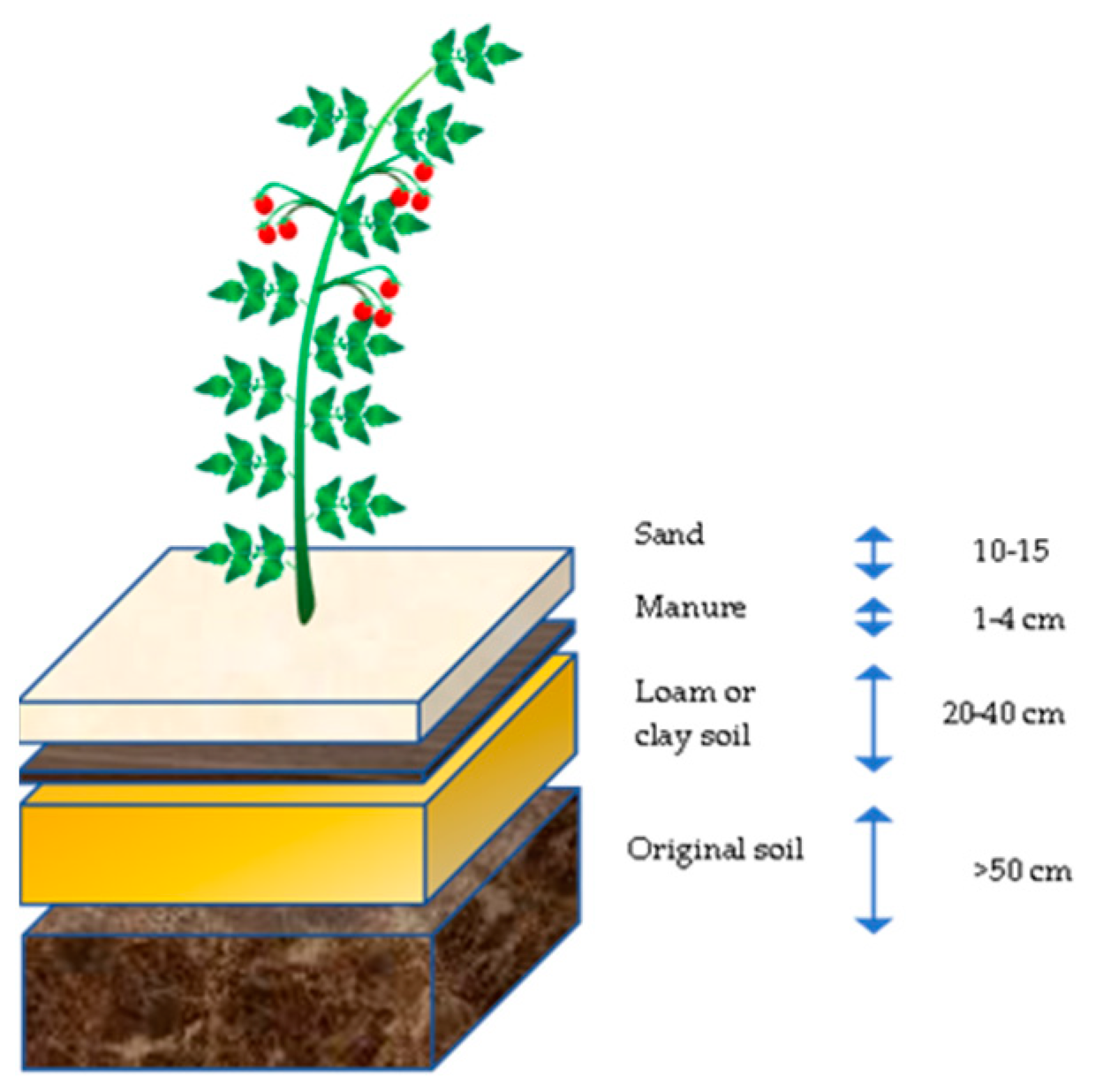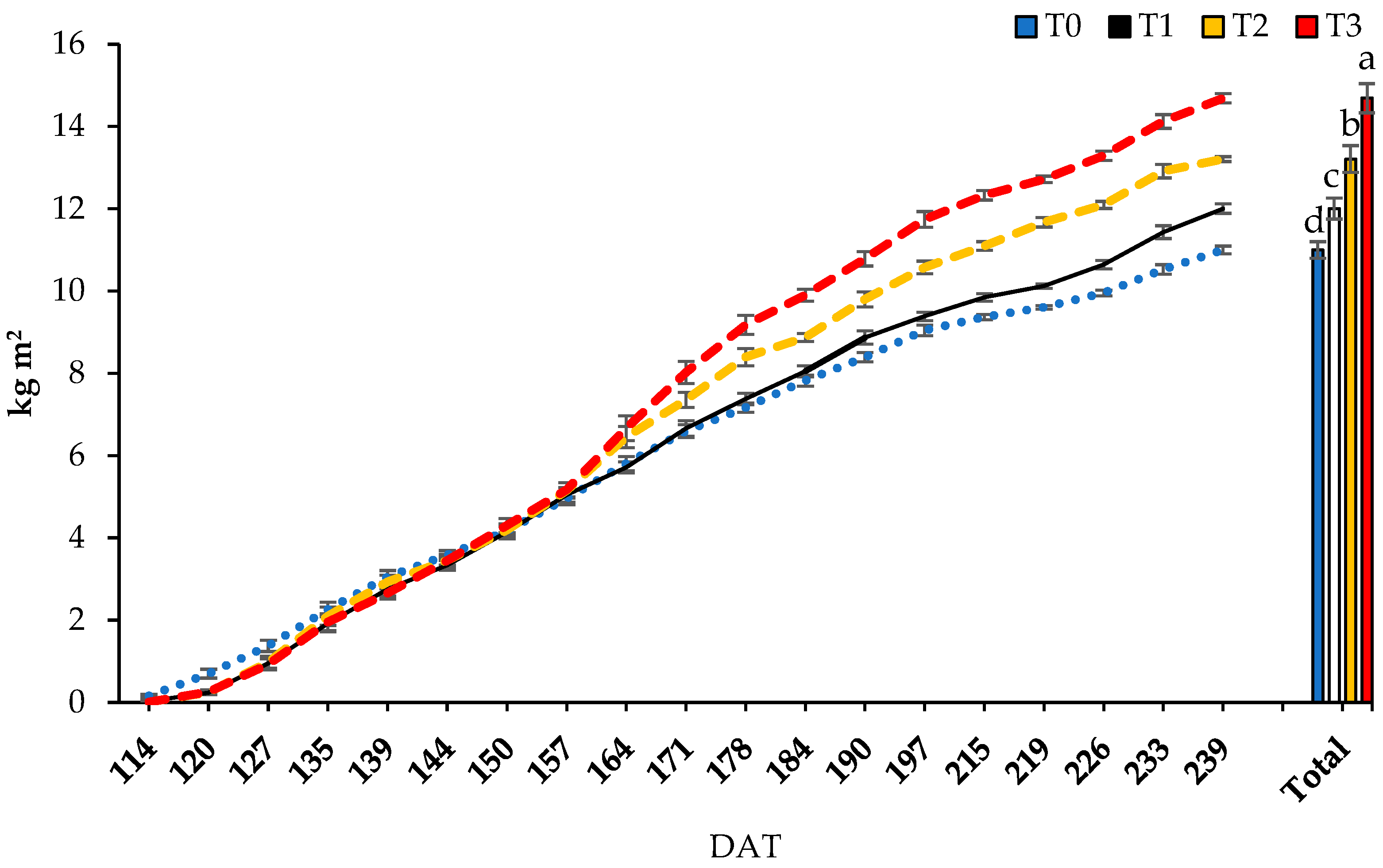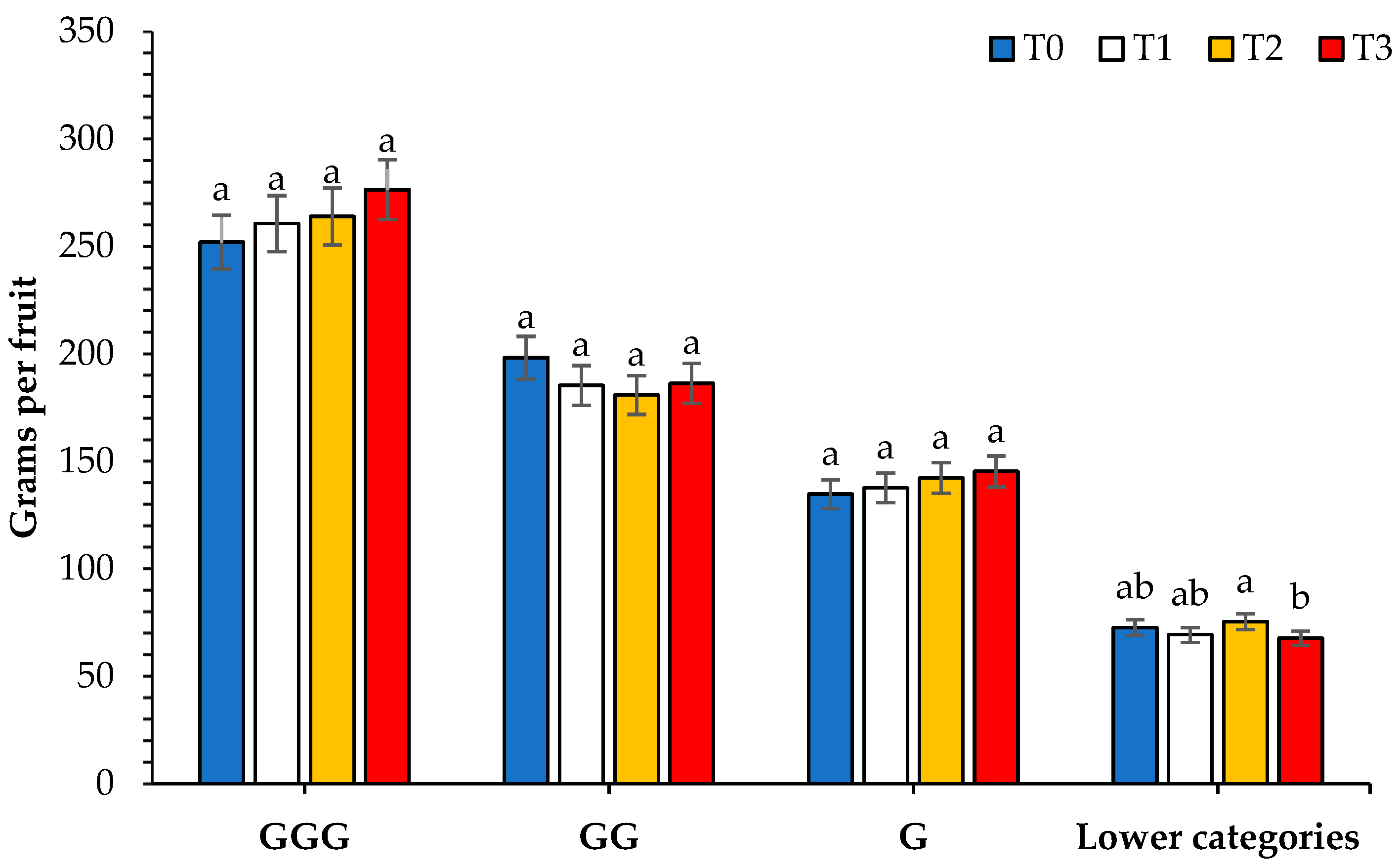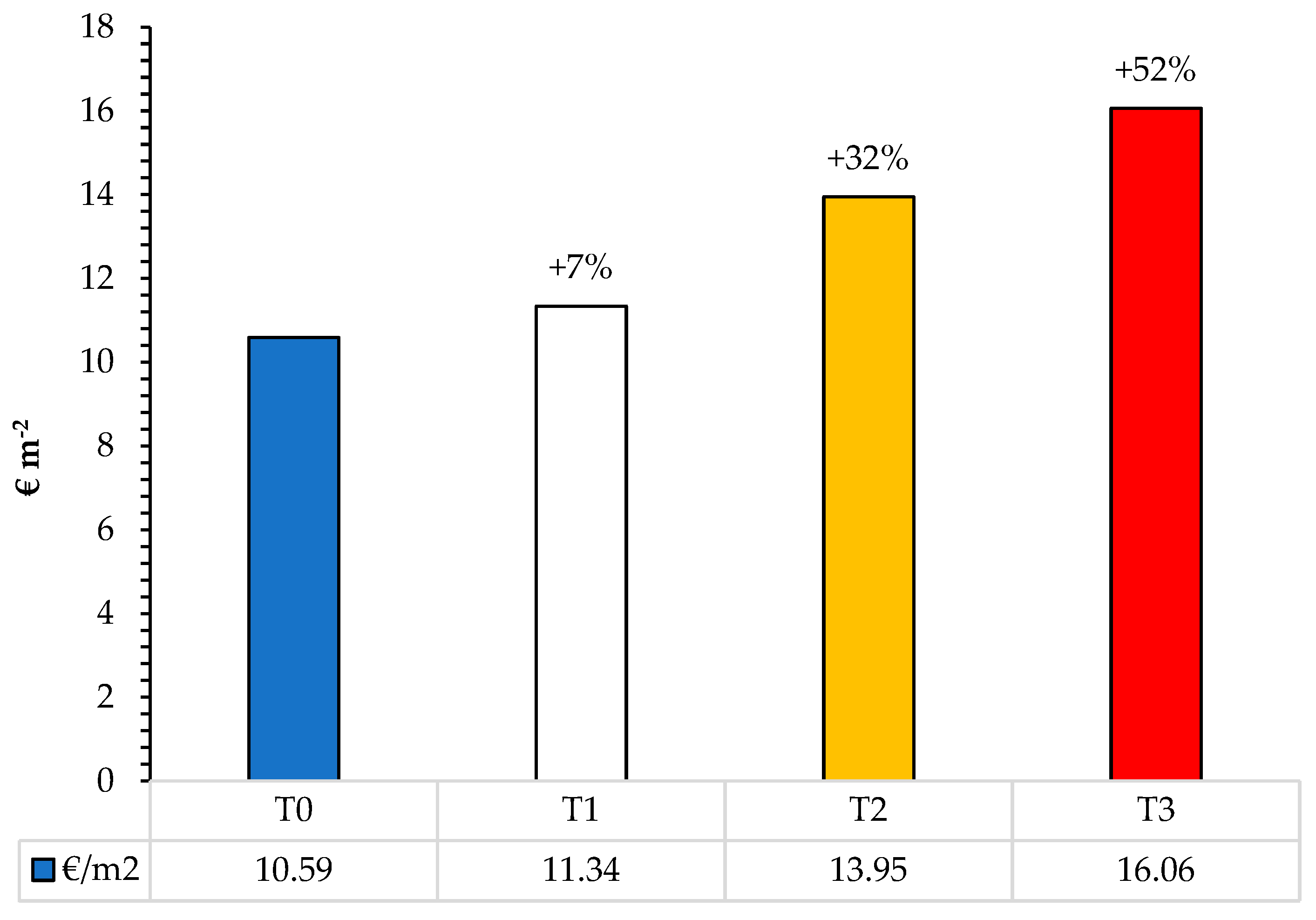Biofertilizers Enriched with PGPB Improve Soil Fertility and the Productivity of an Intensive Tomato Crop
Abstract
:1. Introduction
2. Materials and Methods
2.1. Location and Crop Characteristics
2.2. Fertigation System
2.3. Biofertilizers
2.4. Treatments and Experimental Design
2.5. Fruit Production and Quality
2.6. NPK Macronutrient Analysis in Soils, Leaves, and Fruits
2.7. Statistical Analysis
3. Results and Discussion
3.1. Harvest Productivity
3.2. NPK Contents in Soils, Leaves, and Fruits
3.2.1. NPK Contents in Soils
3.2.2. NPK Contents in Leaves
3.2.3. NPK Contents in Fruits
3.3. Quality Parameters in Fruits
3.4. Economic Performance
4. Conclusions
Author Contributions
Funding
Institutional Review Board Statement
Informed Consent Statement
Data Availability Statement
Acknowledgments
Conflicts of Interest
References
- Jiménez-Díaz, J.F. Procesos de desarrollo en el poniente almeriense: Agricultores e inmigrados. Rev. Estud. Reg. 2011, 90, 179–206. [Google Scholar]
- FAOSTAT. Available online: https://www.fao.org/faostat/en/#data/QCL/visualize (accessed on 23 March 2023).
- INE. Instituto Nacional de Estadística. Available online: https://www.ine.es/dyngs/INEbase/es/categoria.htm?c=Estadistica_P&cid=1254735727106 (accessed on 23 March 2023).
- Cajamar. Análisis de la Campaña Hortofrutícola de Almería Campaña 2021–2022; Cajamar Caja Rural: Almería, Spain, 2022; pp. 1–101. [Google Scholar]
- García Lorca, A. Tendencias y transformaciones en la agricultura intensiva almeriense. Nimbus 1999, 4, 109–128. [Google Scholar]
- Ramos Miras, J.J.; Gil de Carrasco, C.; Boluda-Hernández, R. Estudio da las características de los antrosoles cumílicos de los invernaderos de la comarca del poniente almeriense. Influencia de las prácticas agrícolas sobre los cambios de sus propiedades. Edafología 2002, 9, 129–142. [Google Scholar]
- van Rijswick, C. World Vegetable Map 2018. Available online: https://research.rabobank.com/far/en/sectors/regional-food-agri/world_vegetable_map_2018.html (accessed on 24 March 2023).
- Aguado Santacruz, G.A.; Moreno Gómez, B. Biofertilizantes bacterianos desarrollados por el INIFAP. In Introducción al Uso y Manejo de los Miofertilizantes en la Agricultura; Aguado Santacruz, G.A., Ed.; Instituto Nacional de Investigaciones Forestales, Agrícolas y Pecuarias (INIFAP): Celaya, Guanajuato, Mexico, 2012; pp. 151–170. [Google Scholar]
- Murphy, J.F.; Reddy, M.S.; Ryu, C.-M.; Kloepper, J.W.; Li, R. Rhizobacteria-mediated growth gromotion of tomato leads to protection against Cucumber Mosaic Virus. Phytopathology 2003, 93, 1301–1307. [Google Scholar] [CrossRef]
- Mehta, P.; Walia, A.; Kulshrestha, S.; Chauhan, A.; Shirkot, C.K. Efficiency of plant growth-promoting P-solubilizing Bacillus circulans CB7 for enhancement of tomato growth under net house conditions. J. Basic Microbiol. 2015, 55, 33–44. [Google Scholar] [CrossRef] [PubMed]
- Reyes-Castillo, A.; Gerding, M.; Oyarzúa, P.; Zagal, E.; Gerding, J.; Fischer, S. Plant growth-promoting rhizobacteria able to improve NPK availability: Selection, identification and effects on tomato growth. Chil. J. Agric. Res. 2019, 79, 473–485. [Google Scholar] [CrossRef]
- Kalozoumis, P.; Savvas, D.; Aliferis, K.; Ntatsi, G.; Marakis, G.; Simou, E.; Tampakaki, A.; Karapanos, I. Impact of plant growth-promoting rhizobacteria inoculation and grafting on tolerance of tomato to combined water and nutrient stress assessed via metabolomics analysis. Front. Plant Sci. 2021, 12, 670236. [Google Scholar] [CrossRef]
- Calvo García, S. Bacterias simbióticas fijadoras de nitrógeno. Cuad. Tomás 2011, 3, 173–186. [Google Scholar]
- Corrales Ramírez, L.C.; Arévalo Galvez, Z.Y.; Moreno Burbano, V.E. Solubilización de fosfatos: Una función microbiana importante en el desarrollo vegetal. Nova 2014, 12, 68–79. [Google Scholar] [CrossRef]
- Florez Jalixto, M.A.; Roldán Acero, D.J.; Juscamaita Morales, J.G. Phytotoxicity and characterization of a liquid fertilizer produced by lactic acid fermentation using rainbow trout by-products (Oncorhynchus mykiss). Ecol. Apl. 2020, 19, 121–131. [Google Scholar] [CrossRef]
- Rouphael, Y.; Colla, G. Toward a sustainable agriculture through plant biostimulants: From experimental data to practical applications. Agronomy 2020, 10, 1461. [Google Scholar] [CrossRef]
- Gashash, E.A.; Osman, N.A.; Alsahli, A.A.; Hewait, H.M.; Ashmawi, A.E.; Alshallash, K.S.; El-Taher, A.M.; Azab, E.S.; Abd El-Raouf, H.S.; Ibrahim, M.F.M. Effects of plant-growth-promoting rhizobacteria (PGPR) and cyanobacteria on botanical characteristics of tomato (Solanum lycopersicon L.) plants. Plants 2022, 11, 2732. [Google Scholar] [CrossRef]
- De Pascale, S.; Rouphael, Y.; Colla, G. Plant biostimulants: Innovative tool for enhancing plant nutrition in organic farming. Eur. J. Hortic. Sci. 2018, 82, 277–285. [Google Scholar] [CrossRef]
- Shao, J.; Xu, Z.; Zhang, N.; Shen, Q.; Zhang, R. Contribution of indole-3-acetic acid in the plant growth promotion by the rhizospheric Strain Bacillus amyloliquefaciens SQR9. Biol. Fertil. Soils 2015, 51, 321–330. [Google Scholar] [CrossRef]
- De Jong, M.; Mariani, C.; Vriezen, W.H. The role of auxin and gibberellin in tomato fruit set. J. Exp. Bot. 2009, 60, 1523–1532. [Google Scholar] [CrossRef]
- Bona, E.; Todeschini, V.; Cantamessa, S.; Cesaro, P.; Copetta, A.; Lingua, G.; Gamalero, E.; Berta, G.; Massa, N. Combined bacterial and mycorrhizal inocula improve tomato quality at reduced fertilization. Sci. Hortic. 2018, 234, 160–165. [Google Scholar] [CrossRef]
- García-García, M.C.; Céspedes, A.J.; Lorenzo, P.; Pérez-Parra, P.P.; Escudero, M.C.; Sánchez-Guerrero, M.C.; Medrano, E.; Baeza, E.; López, J.C.; Magán, J.J.; et al. El Sistema de Producción Hortícola de la Provincia de Almería, 1st ed.; IFAPA (Instituto de Formación Agraria y Pesquera de Andalucía): Huelva, Spain, 2016; pp. 1–179. [Google Scholar]
- Sumbul, A.; Ansari, R.A.; Rizvi, R.; Mahmood, I. Azotobacter. A potential bio-fertilizer for soil and plant health management. Saudi J. Biol. Sci. 2020, 27, 3634–3640. [Google Scholar] [CrossRef] [PubMed]
- Kasa, P.; Modugapalem, H.; Battini, K. Isolation, screening, and molecular characterization of plant growth promoting rhizobacteria isolates of Azotobacter and Trichoderma and their beneficial activities. J. Nat. Sci. Biol. Med. 2015, 6, 360–363. [Google Scholar] [CrossRef]
- FAO; WHO. Codex Standard for Tomatoes CODEX STAN 293-2008. Available online: https://www.fao.org/fao-who-codexalimentarius/codex-texts/list-standards/en/ (accessed on 24 March 2023).
- Nájera, C.; Guil-Guerrero, J.L.; Enríquez, L.J.; Álvaro, J.E.; Urrestarazu, M. LED-enhanced dietary and organoleptic qualities in postharvest tomato fruit. Postharvest Biol. Technol. 2018, 145, 151–156. [Google Scholar] [CrossRef]
- Hochmuth, G.; Hochmuth, R. Plant petiole sap-testing for vegetable crops: CV004/CIR1144, Rev. 5/2022. EDIS 2022, 2022, 1–6. [Google Scholar] [CrossRef]
- Kjeldahl, J. Neue Methode zur bestimmung des stickstoffs in organischen körpern. Z. Anal. Chem. 1883, 22, 366–382. [Google Scholar] [CrossRef]
- Olsen, S.R.; Cole, C.V.; Watanabe, F.S.; Dean, L.A. Estimation of Available Phosphorus in Soils by Extraction with Sodium Bicarbonate; United States Department of Agriculture: Washington, DC, USA, 1954; pp. 1–19.
- Soil Survey Staff. Soil Survey Laboratory Methods Manual. Soil Survey Laboratory Investigations Report No. 42, USDA-NRCS; National Soil Survey Center: Lincoln, NE, USA, 2004.
- González Rodríguez, G.; Espinosa Palomeque, B.; Cano Ríos, P.; Moreno Reséndez, A.; Leos Escobedo, L.; Sánchez Galván, H.; Sáenz Mata, J.; González Rodríguez, G.; Espinosa Palomeque, B.; Cano Ríos, P.; et al. Influencia de rizobacterias en la producción y calidad nutracéutica de tomate bajo condiciones de invernadero. Rev. Mex. Cienc. Agric. 2018, 9, 367–379. [Google Scholar] [CrossRef]
- Katsenios, N.; Andreou, V.; Sparangis, P.; Djordjevic, N.; Giannoglou, M.; Chanioti, S.; Stergiou, P.; Xanthou, M.-Z.; Kakabouki, I.; Vlachakis, D.; et al. Evaluation of plant growth promoting bacteria strains on growth, yield and quality of industrial tomato. Microorganisms 2021, 9, 2099. [Google Scholar] [CrossRef] [PubMed]
- Ruiz-Cisneros, M.F.; Ornelas-Paz, J.J.; Olivas-Orozco, G.I.; Acosta-Muñiz, C.H.; Sepúlveda-Ahumada, D.R.; Zamudio-Flores, P.B.; Berlanga-Reyes, D.I.; Salas-Marina, M.A.; Cambero-Campos, O.J.; Rios-Velasco, C. Efecto de cepas de Bacillus solas y en interacción con hongos fitopatógenos sobre el crecimiento vegetal y calidad del fruto de jitomate. Rev. Bio Cienc. 2019, 6, 17. [Google Scholar] [CrossRef]
- Luna, M.F.; Aprea, J.; Crespo, J.M.; Boiardi, J.L. Colonization and yield promotion of tomato by Gluconacetobacter diazotrophicus. Appl. Soil Ecol. 2012, 61, 225–229. [Google Scholar] [CrossRef]
- Hernández-Montiel, L.G.; Chiquito Contreras, C.J.; Murillo Amador, B.; Vidal Hernández, L.; Quiñones Aguilar, E.E.; Chiquito Contreras, R.G. Efficiency of two inoculation methods of Pseudomonas putida on growth and yield of tomato plants. J. Soil Sci. Plant Nutr. 2017, 17, 1003–1012. [Google Scholar] [CrossRef]
- Espinosa Palomeque, B.; Moreno Reséndez, A.; Cano Ríos, P.; de Álvarez Reyna, V.P.; Sáenz Mata, J.; Galván, H.; González Rodríguez, G. Inoculación de rizobacterias promotoras del crecimiento vegetal en tomate (Solanum lycopersicum L.) cv. Afrodita en invernadero. Tierra Latinoam. 2017, 35, 169–178. [Google Scholar] [CrossRef]
- Aini, N.; Dwi Yamika, W.S.; Wahidah Pahlevi, R. The Effect of nutrient concentration and inoculation of PGPR and AMF on the yield and fruit quality of hydroponic cherry tomatoes (Lycopersicum esculentum Mill. var. Cerasiforme). J. Appl. Hortic. 2019, 21, 116–122. [Google Scholar] [CrossRef]
- Fernández Fernández, M.M.; Aguilar Pérez, M.I.; Carrique Pérez, J.R.; Tortosa Domingo, J.; García García, C.; López Rodríguez, M.; Pérez Morales, J.M. Suelo y Medio Ambiente en Invernaderos, 5th ed.; Junta de Andalucía, Consejería de Agricultura, Pesca y Desarrollo Rural: Sevilla, España, 2014; pp. 1–135. [Google Scholar]
- Saia, S.; Aissa, E.; Luziatelli, F.; Ruzzi, M.; Colla, G.; Ficca, A.G.; Cardarelli, M.; Rouphael, Y. Growth-promoting bacteria and arbuscular mycorrhizal fungi differentially benefit tomato and corn depending upon the supplied form of phosphorus. Mycorrhiza 2020, 30, 133–147. [Google Scholar] [CrossRef]
- Ordookhani, K.; Khavazi, K.; Moezzi, A.; Rejali, F. Influence of PGPR and AMF on antioxidant activity, lycopene and potassium contents in tomato. Afr. J. Agric. Res. 2010, 5, 1108–1116. [Google Scholar]
- Zhao, Y.; Zhang, M.; Yang, W.; Di, H.J.; Ma, L.; Liu, W.; Li, B. Effects of microbial inoculants on phosphorus and potassium availability, bacterial community composition, and chili pepper growth in a calcareous soil: A greenhouse study. J. Soils Sediments 2019, 19, 3597–3607. [Google Scholar] [CrossRef]






| Phase | Tank 1 | Tank 2 | Tank 3 | Tank 4 |
|---|---|---|---|---|
| Growth | 17 | 33 | 33 | 17 |
| Setting | 33 | 33 | 20 | 13 |
| Collection | 33 | 33 | 11 | 22 |
| Inoculation with PGPR | DAT | T0 | T1 | T2 | T3 * |
|---|---|---|---|---|---|
| 1st | 12 | x | x | x | |
| 2nd | 52 | x | x | ||
| 3rd | 92 | x | x | ||
| 4th | 120 | x | x | ||
| 5th | 162 | x | x |
| Treatment | Leaf | Fruit | ||||
|---|---|---|---|---|---|---|
| N | P | K | N | P | K | |
| % | % | |||||
| T0 | 3.54 ± 0.17 b | 0.29 ± 0.01 a | 3.45 ± 0.20 b | 1.83 ± 0.01 b | 0.32 ± 0.02 a | 3.17 ± 0.11 b |
| T1 | 3.61 ± 0.14 b | 0.39 ± 0.06 b | 3.12 ± 0.34 b | 1.62 ± 0.08 a | 0.33 ± 0.03 a | 3.34 ± 0.07 c |
| T2 | 3.47 ± 0.12 b | 0.42 ± 0.09 b | 3.38 ± 0.51 b | 1.66 ± 0.03 a | 0.35 ± 0.02 a | 3.06 ± 0.09 ab |
| T3 | 3.08 ± 0.13 a | 0.46 ± 0.07 b | 2.64 ± 0.15 a | 1.59 ± 0.05 a | 0.32 ± 0.01 a | 2.91 ± 0.11 a |
| Treatment | N (g/m2) | Increase (%) | P (g/m2) | Increase (%) | K (g/m2) | Increase (%) |
|---|---|---|---|---|---|---|
| T0 | 9.26 | - | 1.62 | - | 16.01 | - |
| T1 | 8.63 | −6.81 | 1.76 | 8.73 | 17.78 | 11.09 |
| T2 | 8.93 | −3.5 | 1.88 | 16.54 | 16.47 | 2.85 |
| T3 | 10.74 | 16.01 | 2.16 | 33.73 | 19.65 | 22.77 |
| Treatment | pH | EC (mS/cm) | Firmness (N) | TSS (%) | TA (%) | Maturity Index |
|---|---|---|---|---|---|---|
| T0 | 4.52 ± 0.03 b | 7.00 ± 0.13 c | 34.91 ± 4.12 a | 6.10 ± 1.01 a | 0.59 ± 0.05 a | 10.27 ± 1.10 a |
| T1 | 4.43 ± 0.09 ab | 6.70 ± 0.44 bc | 38.78 ± 8.92 a | 6.00 ± 1.00 a | 0.58 ± 0.02 a | 10.39 ± 1.43 a |
| T2 | 4.42 ± 0.09 ab | 6.47 ± 0.15 b | 33.20 ± 5.88 a | 6.33 ± 0.58 a | 0.59 ± 0.03 a | 10.65 ± 0.42 a |
| T3 | 4.37 ± 0.05 a | 5.97 ± 0.07 a | 36.19 ± 6.64 a | 6.17 ± 0.29 a | 0.53 ± 0.04 a | 11.65 ± 0.29 a |
Disclaimer/Publisher’s Note: The statements, opinions and data contained in all publications are solely those of the individual author(s) and contributor(s) and not of MDPI and/or the editor(s). MDPI and/or the editor(s) disclaim responsibility for any injury to people or property resulting from any ideas, methods, instructions or products referred to in the content. |
© 2023 by the authors. Licensee MDPI, Basel, Switzerland. This article is an open access article distributed under the terms and conditions of the Creative Commons Attribution (CC BY) license (https://creativecommons.org/licenses/by/4.0/).
Share and Cite
Ortega Pérez, R.; Nieto García, J.C.; Gallegos-Cedillo, V.M.; Domene Ruiz, M.Á.; Santos Hernández, M.; Nájera, C.; Miralles Mellado, I.; Diánez Martínez, F. Biofertilizers Enriched with PGPB Improve Soil Fertility and the Productivity of an Intensive Tomato Crop. Agronomy 2023, 13, 2286. https://doi.org/10.3390/agronomy13092286
Ortega Pérez R, Nieto García JC, Gallegos-Cedillo VM, Domene Ruiz MÁ, Santos Hernández M, Nájera C, Miralles Mellado I, Diánez Martínez F. Biofertilizers Enriched with PGPB Improve Soil Fertility and the Productivity of an Intensive Tomato Crop. Agronomy. 2023; 13(9):2286. https://doi.org/10.3390/agronomy13092286
Chicago/Turabian StyleOrtega Pérez, Raúl, José Carlos Nieto García, Victor M. Gallegos-Cedillo, Miguel Ángel Domene Ruiz, Mila Santos Hernández, Cinthia Nájera, Isabel Miralles Mellado, and Fernando Diánez Martínez. 2023. "Biofertilizers Enriched with PGPB Improve Soil Fertility and the Productivity of an Intensive Tomato Crop" Agronomy 13, no. 9: 2286. https://doi.org/10.3390/agronomy13092286
APA StyleOrtega Pérez, R., Nieto García, J. C., Gallegos-Cedillo, V. M., Domene Ruiz, M. Á., Santos Hernández, M., Nájera, C., Miralles Mellado, I., & Diánez Martínez, F. (2023). Biofertilizers Enriched with PGPB Improve Soil Fertility and the Productivity of an Intensive Tomato Crop. Agronomy, 13(9), 2286. https://doi.org/10.3390/agronomy13092286





